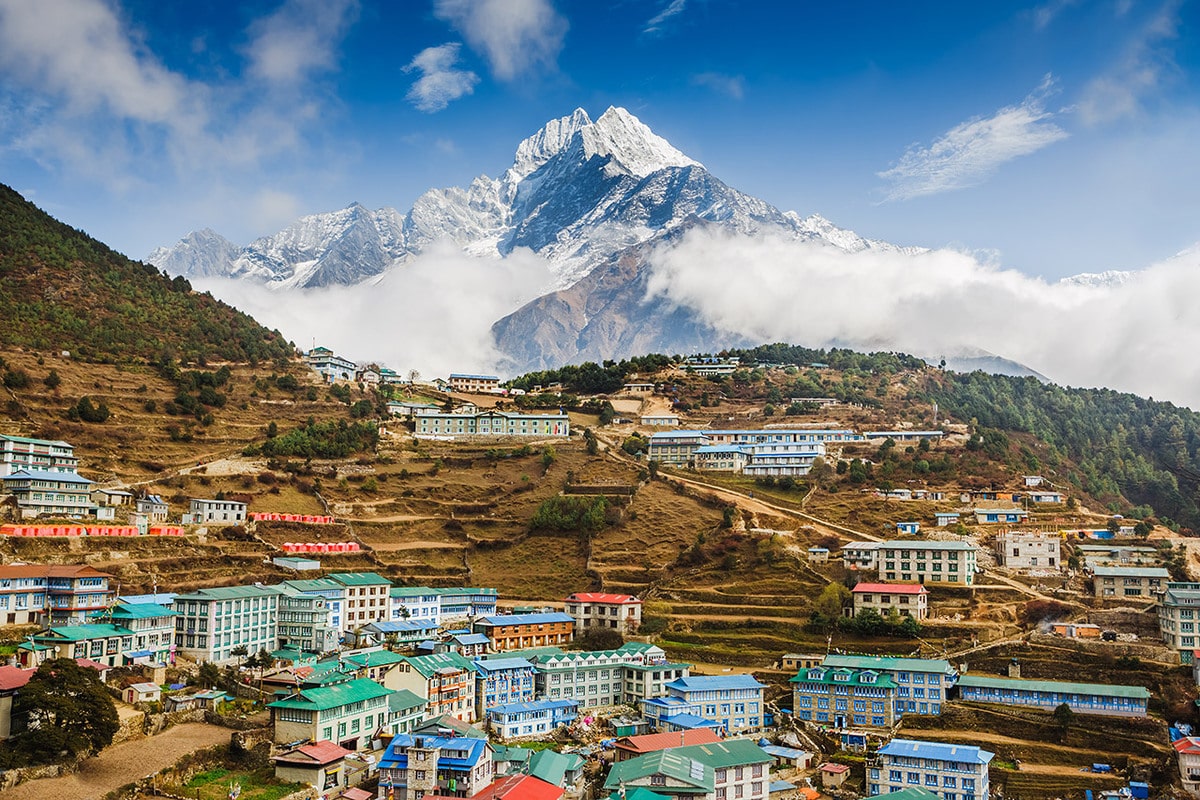Nepal is a country where majestic mountains meet spiritual depth, where ancient traditions coexist with the rhythm of modern life. It is not only home to the world’s highest peak but also a land rich in culture, religion, and natural diversity. Though small in size, Nepal holds an incredible variety of languages, customs, landscapes, and beliefs. These interesting facts offer a deeper understanding of a nation that remains mysterious to many. You may not have known just how extraordinary this Himalayan country really is.
- Nepal is the only country in the world whose national flag is not rectangular. The flag consists of two stacked triangles, symbolizing the Himalayas and the country’s two dominant religions — Hinduism and Buddhism. The upper triangle features a moon, while the lower triangle depicts the sun. It is one of the most unique and recognizable flags globally.
- The world’s highest point, Mount Everest — known locally as Sagarmatha — is located in Nepal. It stands at 8,848 meters and attracts thousands of climbers each year. For many local communities, the mountain holds deep spiritual meaning. Climbing Everest requires not only physical strength but also a special permit from the Nepali government.
- Kathmandu, the capital of Nepal, is one of the oldest cities in South Asia and is renowned for its architectural and spiritual heritage. The Kathmandu Valley is listed as a UNESCO World Heritage Site for its historic temples, palaces, and monuments. The city features intricate wood carvings and centuries-old religious structures. Despite modernization, it retains the essence of ancient Eastern culture.
- Nepal is the birthplace of Siddhartha Gautama, who became the Buddha. His birthplace, Lumbini, is a major pilgrimage site for Buddhists around the world. The area includes monasteries built by various nations and ancient archaeological ruins. Lumbini holds great religious and historical significance both locally and internationally.
- Nepal is one of the few countries in the world that has never been colonized by a European power. Despite attempts by the British Empire, the country preserved its independence, largely due to the bravery of the Gurkha soldiers. Gurkhas are legendary warriors who still serve in the armies of the UK and India. Their motto is “Better to die than be a coward.”
- The official language of Nepal is Nepali, but over 120 languages and dialects are spoken throughout the country. This reflects the nation’s rich ethnic and cultural diversity. Nepal is home to groups such as the Sherpa, Tamang, Magar, Rai, and many others. Each group maintains distinct traditions, attire, and rituals.
- Nepal has an incredibly diverse climate, ranging from tropical lowlands to alpine highlands. As a result, it is home to over 6,000 species of plants and rare animals such as the snow leopard, red panda, and Himalayan black bear. The country has several national parks, the most famous being Chitwan National Park. It protects dense jungles and a wide range of wildlife including rhinos, elephants, and tigers.
- Nepal uses a unique calendar system called Bikram Sambat, which is approximately 56 to 57 years ahead of the Gregorian calendar. This calendar is used officially alongside the Western system. The Nepali New Year falls in April and is celebrated with colorful parades, dancing, and traditional rituals. It is one of the liveliest and most festive times of the year.
- Religion plays a central role in Nepali society, with Hinduism being the dominant faith and Buddhism also widely practiced. What sets Nepal apart is the peaceful coexistence of these religions, often within the same temples. Many religious sites incorporate elements of both Hindu and Buddhist traditions. This religious harmony is a defining feature of Nepalese culture.
- Until 2008, Nepal was the world’s only Hindu kingdom. Following political unrest and mass protests, the country transitioned into a parliamentary republic. Though the monarchy was abolished, royal traditions are still remembered and respected. The former royal palace in Kathmandu is now a public museum.
- Traditional Nepali cuisine is based on rice, lentils, vegetables, and spices. The most popular dish is dal bhat — a combination of rice, lentil soup, and curry. Another beloved food is momo — dumplings filled with meat or vegetables, which have Tibetan origins. Vegetarian meals are common, especially in religious or mountainous regions.
- Nepal is known for its music, folk dances, and colorful festivals. One of the most important is Tihar — the festival of lights — during which homes are decorated and animals are honored. Another unique celebration is Indra Jatra, which blends Hindu, Buddhist, and indigenous traditions. During this festival, the living goddess Kumari makes a rare public appearance.
- Kathmandu is home to the world’s only officially recognized living goddess — the Kumari. She is a young girl chosen through strict criteria and serves as a religious figure until puberty. Regarded as the incarnation of the goddess Taleju, she resides in a special temple-palace. The Kumari is seen by the public only during sacred ceremonies and festivals.
These fascinating facts about Nepal reveal a country of rich history, spiritual depth, and stunning natural beauty. Nepal is more than just a land of mountains — it is a place where ancient traditions and faith live in harmony with nature and everyday life. You may not have realized how many wonders are hidden in this small yet magnificent nation. From the peaks of the Himalayas to the sacred temples, Nepal leaves a lasting impression on all who experience it.





